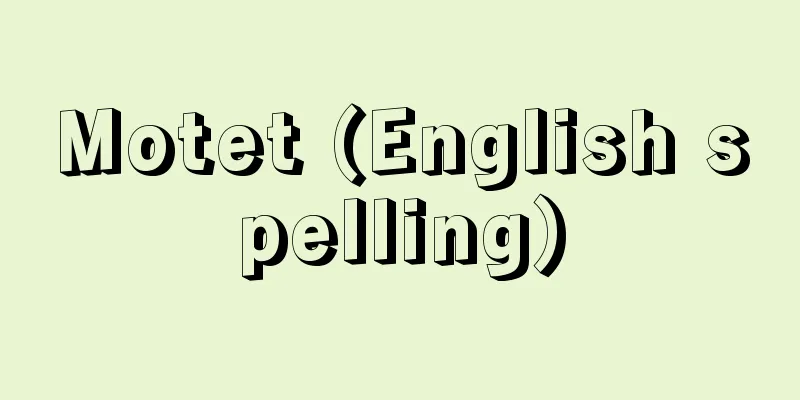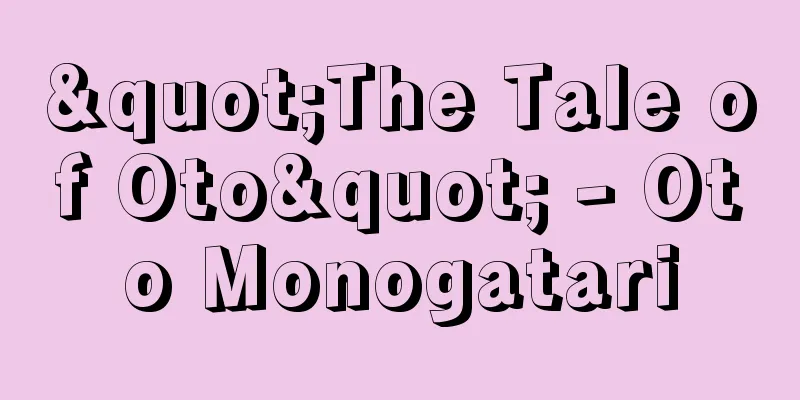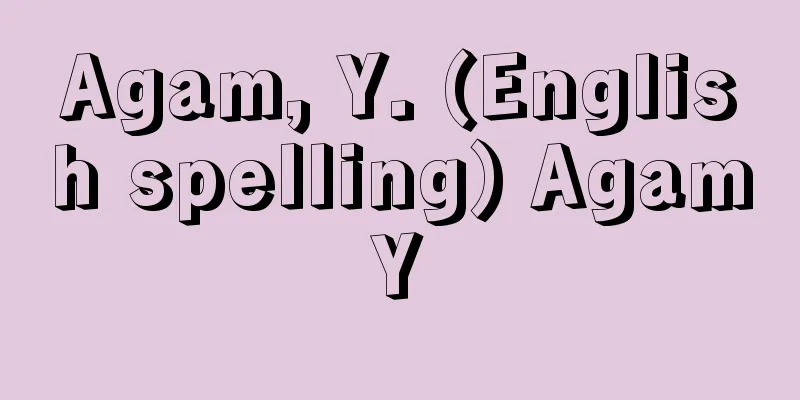Motet (English spelling)

|
An important form of sacred vocal music. Since its establishment in the early 13th century, it has undergone various changes in accordance with the transitions in musical styles of each era, making it impossible to give a unified definition, but generally speaking, it can be thought of as a general term for religious vocal music, mainly in polyphonic style, excluding the mass. The word motet comes from the Old French mot, meaning "words." In the 13th century Notre Dame School organum, the upper voice (dupleme) of the "clausura," an independent piece of music, was originally sung with vowels, but a new lyric mot was given to it, so the upper voice was called a motetus, and eventually the name of the piece itself also became motetus or motet. A double motet is a piece with two upper voices placed on a cantus based on a chant, and a triple motet is a piece with three upper voices. These lyrics were originally in Latin, but gradually they became French, and more often had secular content. This style continued until the 14th century Ars Nova period, represented by Guillaume de Machaut, but a unique singing style like Hocquetus, which divided the melody into short fragments with rests regardless of the lyrics, and a technique called isorhythm (isorhythm) that repeats the same rhythmic type were often used. In the 15th and 16th centuries, many motets were composed in the so-called Renaissance style. Secularity was completely receding, and masterpieces were created as polyphonic religious vocal music, excluding masses, from the Flemish school, which began with Dufay and reached its peak with Josquin des Prez, to the Roman school, represented by Palestrina. Palestrina in particular established the unaccompanied a capella style of performance. In the second half of the 16th century, the Venetian school, represented by Gabrieli, developed the divided choir (compound choir) style, which had a great influence on the Roman school and German composers. In the German Protestant church after the Reformation, motets of the Flemish school were performed, as Luther highly valued Josquin des Prez, but eventually the chorale motet, based on chorales, was established. Schütz introduced the Venetian school of divided chanting and the monody style based on basso continuo to Germany. The motets of J.S. Bach are the pinnacle of the diverse German Baroque style, which also included instrumental and vocal concertos. In France, alongside the magnificent Versailles motets by Lully, Delanande and others, the delicate petits motets by Couperin and others were produced, and in England the anthem was born. After Bach, that is, from the second half of the 18th century onwards, the importance of religious music itself waned under the influence of the Enlightenment, and so the importance of motets also decreased, but Mozart still has many fine pieces such as "Ave Bellum Corpus." Even after the 19th century, Mendelssohn, Schumann, Liszt, Brahms, and especially Bruckner were important in Germany, and contemporary figures such as Distler and Pepping are working to revive the motet, mainly in the German Evangelical Church. France also has a tradition that stretches from Gounod and Franck to Messiaen. [Ryuichi Higuchi] "History of Western Music: Middle Ages and Renaissance" by Tatsuo Minagawa (1986, Ongaku No Tomosha)" ▽ "The Joy of Polyphony" by R. Vliegen (1961, Ongaku No Tomosha) ▽ "Choral Music: Its History and Works" by A. Jacobs, translated by Masaru Hirata and Yoko Matsudaira (1980, Zen-On Music Publishers)" Source: Shogakukan Encyclopedia Nipponica About Encyclopedia Nipponica Information | Legend |
|
宗教的声楽曲の重要な一形式。13世紀初頭に成立して以来、それぞれの時代の音楽形式の変遷に従って多様な変化を遂げたため、統一的な定義は不可能だが、ごく一般的には、ミサ曲を除く主としてポリフォニー(多声)様式による宗教的声楽曲の総称と考えてよい。 モテットの語源は、「ことば」を意味する古いフランス語のmotに由来する。13世紀のノートルダム楽派オルガヌムでは独立した楽曲としての「クラウスラ」の上声部(ドゥプルム)は本来母音で歌われたが、それに新しい歌詞motが与えられたため、その上声部がモテトゥスとよばれ、やがて楽曲自体の名称もモテトゥスないしモテットとなった。聖歌に基づく定旋律の上に二つの上声部が置かれたものを二重モテット、三つ置かれたものを三重モテットという。これらの歌詞は、初めはラテン語だったが、しだいにフランス語、しかも世俗的な内容のものが多くなった。これはギヨーム・ド・マショーに代表される14世紀のアルス・ノバ期まで引き継がれたが、旋律を歌詞に関係なく休符を挟んだ短い断片にしてしまうホケトゥスのような特異な唱法や、同一リズム型の反復によるイソ・リズム(アイソリズム)という技法が多用された。 15~16世紀になると、いわゆるルネサンス様式のモテットが多数作曲された。世俗性は完全に後退し、広くミサ曲を除いたポリフォニーによる宗教的声楽曲として、デュファイに始まりジョスカン・デ・プレで頂点に達するフランドル楽派から、パレストリーナに代表されるローマ楽派に至る傑作群を形成した。とくにパレストリーナにおいては、無伴奏のア・カペラ様式の演奏法が確立された。16世紀後半、ガブリエリに代表されるベネチア楽派では、合唱を分割する分割合唱(複合唱)様式が生まれたが、これはローマ楽派やドイツの作曲家にも大きな影響を及ぼした。 宗教改革後のドイツ・プロテスタント教会では、ルターがジョスカン・デ・プレを高く評価していたように、フランドル楽派のモテットが演奏されたが、やがてコラールに基づいたコラール・モテットが確立された。シュッツはベネチア楽派の分割合唱や、通奏低音法に基づいたモノディ様式をドイツに導入した。器楽と声楽の協奏も含めた多彩なドイツ・バロック様式の頂点がJ・S・バッハのモテットである。 フランスではリュリ、ドラランドらの壮麗なベルサイユ・モテットと並んでクープランらの繊細なプチ・モテも生まれ、イギリスではアンセムが生まれた。 バッハ以後、つまり18世紀後半以降は、啓蒙(けいもう)主義の影響で宗教音楽そのものの重要性が薄れたためモテットの比重も小さくなったが、モーツァルトには『アベ・ベルム・コルプス』などの佳品も少なくない。19世紀以降もドイツではメンデルスゾーン、シューマン、リスト、ブラームス、とくにブルックナーが重要で、現代のディストラー、ペッピングなどは、ドイツ福音(ふくいん)教会を中心にモテットの復興に努めている。フランスにもグノー、フランクからメシアンに至る伝統がある。 [樋口隆一] 『皆川達夫著『西洋音楽史 中世・ルネサンス』(1986・音楽之友社)』▽『R・ヴリーゲン著『ポリフォニーに見る歓び』(1961・音楽之友社)』▽『A・ジェイコブズ著、平田勝・松平陽子訳『合唱音楽――その歴史と作品』(1980・全音楽譜出版社)』 出典 小学館 日本大百科全書(ニッポニカ)日本大百科全書(ニッポニカ)について 情報 | 凡例 |
Recommend
Hans Erich Nossack
German novelist. Born into a trading family in Ha...
Confinement - Confinement
A type of immediate coercion stipulated in the ol...
Yurimizu - Yurimizu
A terrestrial animal belonging to the family Tubi...
Woman Killing Oil Hell - Woman Killing Oil Hell
Joruri Gidayubushi (a type of Japanese drama with...
Remains - Iko (English) structure
Among the traces left by humans, those that cannot...
Shimouke Dam - Shimouke Dam
This dam is located on the Tsue River, a tributary...
Hiromichi Akamatsu
1562-1600 A military commander during the Oda-Toy...
Bourgeoisie (English spelling) bourgeoisie French
The capitalist class in capitalist society. In Fr...
Carcharhinus melanopterus (English spelling) Carcharhinusmelanopterus
…Shark [Toru Taniuchi]. . . *Some of the terminol...
oilphilic radical
...A group of atoms in a molecule that hates wate...
Coelostat - Coelostat (English spelling)
A device that always sends light from the sun and...
Wall mirror - Kabekagami
…Glass mirrors made from a compound of tin and me...
Exogenous branching
…the apical meristem of a stem is derived from th...
Genpei War
A series of conflicts and struggles between the Se...
Edo School
〘 noun 〙 A school that was active in Edo. ① A scho...









